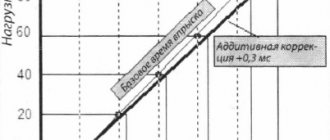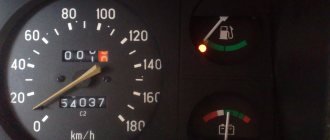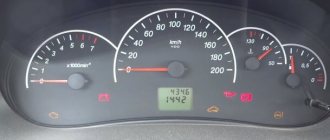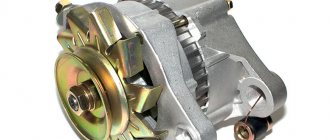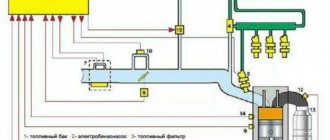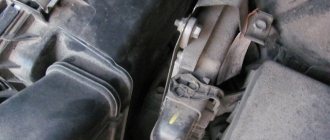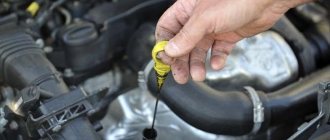The fuel consumption of the VAZ 2107 per 100 km depends on many factors. These include the following: vehicle speed, engine type and fuel supply system. What is the fuel consumption of a VAZ 2107 with a carburetor? According to documents for this model of car, the average fuel consumption on the highway is 6.8 liters, if the speed is about 90 km/h. P When driving in city mode, this figure increases significantly - up to 9.6 liters.
What you need to know to reduce fuel consumption
Checking the air damper in the carburetor
Higher fuel consumption on a VAZ 2107 with a carburetor engine occurs if the air damper is not fully open. What is its correct position? Surely, an experienced driver knows that when the engine in the car is running, the choke in the carburetor must be in a vertical position. The choke handle must be fully extended towards you. Fuel consumption at idle speed in the VAZ 2107 can be reduced by specially setting the carburetor air damper to some extent. But such manipulation is not effective enough.
| Engine | Consumption (highway) | Consumption (city) | Consumption (mixed cycle) |
| 1.3 l 4-mech (gasoline) | 7.8 l/100 km | 11.5 l/100 km | 10.5 l/100 km |
| 1.4 l 5-mech (gasoline) | — | 9 l/100 km | — |
| 1.5 l 5-mech (gasoline) | 5.2 l/100 km | 8.9 l/100 km | 7 l/100 km |
| 1.6 l 5-mech (gasoline) | — | 8.5 l/100 km | — |
| 1.3 l 5-mech (gasoline) | 9.5 l/100 km | 12.5 l/100 km | 11 l/100 km |
The reasons for the high fuel consumption on VAZ 2107, the carburetor of which is in a faulty condition, speak for themselves. Young drivers do not always take the time to thoroughly check their car, and this can lead to negative consequences. Other factors of uneconomical fuel consumption may include:
- incorrect speedometer readings;
- malfunction of the device that measures the level of gasoline in the tank;
- driver's driving style.
VAZ 2107: fuel consumption per 100 kilometers
The generally accepted parameter characterizing the “gluttony” of a car - fuel consumption per 100 kilometers - differs significantly even for one model. First of all, fuel consumption depends on driving mode and speed. In the city cycle, when you often have to accelerate and then brake at traffic lights, gasoline is consumed much faster than when driving on the highway. But even on the track you can get completely different performance from one car. At a speed of 80-90 km/h, air resistance is small, and accordingly, consumption is minimal. The higher the speed, the more energy has to be spent to overcome resistance to air flow. The VAZ 2107 does not have good aerodynamics, so the difference in fuel consumption when driving at a speed of 90 and 120 km/h is almost 40%. Consumption is also affected by other parameters: engine condition, fuel quality, tire pressure, road surface quality, etc. You can approximately find out what fuel consumption a VAZ 2107 has from the manufacturer’s specifications. However, in reality the consumption is always slightly higher.
Checking the fuel jet
Also, the reason for the high consumption of gasoline on a VAZ can be the fuel nozzle if its holder is not tightly enclosed. Because of this, during different engine operating modes, much more fuel enters the cylinders than required by the norm. To avoid this situation, check the tightness of the holder. You cannot tighten it too much, but even if it is not tightened completely, this will lead to the fact that the holder can randomly turn out while the machine engine is running. The reason for the overconsumption is that the diameter of the jets is too large or they are dirty.
Basic methods for optimizing and adjusting fuel consumption
To reduce fuel costs during year-round vehicle operation, you must:
adjust your driving style, eliminating sudden acceleration and movement at speeds of more than 100 km/h;- do not install elements that increase drag (for example, overlays on door windows or oversized mudguards);
- periodically check the ignition system settings and adjust the carburetor;
- replace spark plugs in accordance with the manufacturer's requirements;
- when the Check Engine light turns on (available only on vehicles with a distributed injection system), diagnose the system;
- refuel the car with gasoline with an octane rating of at least 92 units;
- carry out timely maintenance and replace the air filter;
- check the functionality of the cooling system thermostat;
- carry out maintenance of hubs and brake mechanisms with replacement of damaged parts;
- Before leaving, check the tire pressure (flat tires negatively affect efficiency);
- do not use mineral oil with a high pour point in the engine, gearbox and rear axle;
- When operating in winter, warm up the engine for 1-2 minutes before driving.
Excessive fuel consumption on the injector
Owners of new modified VAZ cars with a single electronic control unit may encounter excessive consumption of gasoline at the injector. One of the reasons may be incorrect pressure in the fuel system. Recheck the car's engine management system; there may be a malfunction in its operation.
Also, one of the key problems with fuel consumption can be the failure of an injector or temperature or oxygen sensor. The fuel consumption of a Lada 2107 per 100 km with an injector (engine volume 1.5 liters) in the city in winter should be 9.5-13 liters, and in summer – 7.5-8.5 liters.
Reducing fuel consumption of a car with carburetor 2108, 21081, 21083 Solex
Fuel consumption of VAZ cars
This article outlines the simplest, but no less effective way to improve the fuel efficiency of a passenger car (VAZ 2108, 2109, 21099) with a carburetor engine (Carburetors 2108, 21081, 21083 Solex). This is a method for selecting fuel jets for the main metering system. Moreover, it is only necessary to select the fuel nozzle of the first chamber and configure the idle system. We don't touch the second camera at all. It should be noted that such carburetor tuning leads to a reduction in fuel consumption without noticeable losses in throttle response and power, adapting its parameters to the needs of this particular engine. If your car’s engine “troubles”, emits clouds of black smoke, etc., then most likely you can achieve fuel economy only by overhauling it. The degree of wear can be determined by measuring the compression in the cylinders. If everything is more or less in order, we will perform several necessary procedures and begin setting up the carburetor for economical operation.
1. Determine the vehicle's rated fuel consumption. It is usually listed in any repair manual. On our website there is an article “Fuel consumption of VAZ cars with carburetor engines.” You can use it. As a result of adjusting the carburetor, it will be reduced by approximately 0.3 - 1.0 l/100 km.
2. We check and adjust the main systems and mechanisms of the engine.
— check the spark plugs and adjust the gaps in them;
— we check the serviceability of high-voltage wires, ignition coil, distributor (2108);
— if necessary, adjust the clearances in the valve mechanism;
- Replace the air filter with a new one.
3. We clean and clean the carburetor, both external and internal. We adjust the basic parameters of the carburetor.
4. We check other systems and mechanisms of our car. You can use the article “Increased fuel consumption” for this.
5. We are looking for a more or less deserted section of the road, 3-4 km long.
6. Prepare a one and a half to two liter plastic bottle for gasoline; you can mark it in advance at 100 ml.
7. We stock up on fuel jets for the main metering system in advance. For the first chamber of the carburetor, a smaller cross-section than what you have installed and idle fuel jets (they are inserted into the solenoid valve or a plug that replaces it), on the contrary, have a larger cross-section than the existing ones. You can see what cross-section of jets are installed on your carburetor in the section “Calibration data and parameters of carburetors 2108, 21081, 21083 Solex and 2105, 2107 Ozone” in articles on calibration data.
Setting the carburetor 2108, 21081, 21083 Solex for minimum fuel consumption
1. Warm up the engine to operating temperature (85-90 0 ).
2. Remove the fuel hose from the suction fitting of the fuel pump. We connect this fitting with another hose to a bottle filled with gasoline and installed in the engine compartment of the car.
3. We drive our pre-selected section of 3 km at a speed of 60-70 km/h and see how much the level of gasoline in the bottle has dropped. This will be a control measurement.
4. Remove the carburetor cover and change the fuel jet of the main metering system to the same one, but with a smaller cross-section. For example, “107.5” is changed to “105”.
5. We drive through the control section and check the fuel consumption per bottle
At the same time, we pay attention to the dynamics and the appearance of dips when you press the gas pedal. If everything is in order, change the fuel jet to a smaller one again and carry out a test run again
6. If a “failure” appears when you press the gas pedal, stop experimenting with selecting a fuel nozzle and begin adjusting the idle speed.
7. We change the idle fuel jet to the same one but with a larger cross-section (for example, “40” to “42”), adjust the idle speed and carry out a test run.
The dips are gone - the adjustment was successful, no - we change the fuel jet of the idle system to a larger one and carry out the race again.
As a result of this selection of jets, we achieve stable engine operation at idle, no “failure” when pressing the gas pedal when starting from a stop, while driving, and most importantly, a slight decrease in the engine’s fuel appetite.
Five more articles on the site on carburetor tuning
What needs to be done to optimize fuel consumption
Try to drive without sudden braking or sudden acceleration. To ensure that the actual consumption of the VAZ 2107 does not exceed the norm, replace the use of mineral motor oil with synthetic one.
Check your vehicle regularly and replace the air filter if necessary.
Gasoline consumption 2107 per 100 km (and regardless of the kilometers traveled) at normal vehicle speed also depends on the quality of the fuel, so try to purchase it at large network gas stations. The saving of fuel and your financial resources depends on the technical condition of the car.
The main factors that influence the consumption of fuel and lubricants
The following factors influence fuel consumption:
- driving mode and control features;
- incorrect operation of the carburetor;
- breakdown of the catalytic converter or failure of oxygen concentration sensors (on versions with distributed injection);
- erroneous determination of the optimal speed;
- Air filter contamination and vehicle operation in winter.
Driving style
During sharp acceleration and driving in low gears at high crankshaft speeds, fuel consumption reaches 14-15 liters in urban conditions. When operating on the highway, it is necessary to maintain the speed within 90-100 km/h (optimal mode, independent of the number of gears and engine displacement). Driving on country roads at a speed of more than 120 km/h leads to an increase in gasoline costs to 9-10 liters per 100 km.
VAZ-2107
The tightness of the needle valve is broken
The needle valve is located in the carburetor's float chamber and maintains the gasoline level (along with a float that closes the valve when the required amount of fuel is reached). Overfilling fuel leads to the supply of additional fuel to the carburetor chambers and deterioration of engine efficiency. Gasoline consumption also increases if the float is adjusted incorrectly.
Incorrect speedometer readings
The VAZ-2107 uses a mechanically driven speedometer, which has reduced measurement accuracy. Due to incorrect determination of speed, the driver may operate the gas pedal incorrectly, which negatively affects efficiency. The vehicle's instrument cluster is equipped with an econometer that determines the optimal engine operating mode based on inlet pressure. To reduce fuel consumption, it is necessary to keep the needle in the green zone, which corresponds to costs in the range of 6-8 liters per 100 km.
Fuel jet malfunction
To supply fuel to the carburetor mixing chamber, jets are used that are screwed into the unit body. If the tightening is incorrect or the thread or internal channel of the nozzle is damaged, gasoline consumption increases and the conditions for the formation of the working mixture are violated. An additional reason for carburetor malfunctions is clogging of the jet channels.
Malfunction of the fuel nozzle VAZ-2107
General factors
The main reason affecting fuel consumption is a decrease in air temperature in winter, which increases the engine operating time on a rich mixture. Slippery road surfaces worsen acceleration conditions. Efficiency depends on the condition of the air filter: when the element is clogged, the intake resistance increases and engine power decreases. Winter affects fuel costs: types of engine and transmission oils are selected depending on the climatic zone of operation.
Electric fuel pump
But this is a device that is responsible for ensuring that the required pressure is always present in the ramp. How to reduce fuel consumption will be discussed below. But it is worth noting that the electric pump does not affect this parameter. It is located directly in the tank, combined in a single housing with a gasoline level sensor. It also has a filter. People call it “diaper” due to its external resemblance.
By the way, try to change it as often as possible, otherwise the fuel lines and injectors will become clogged. And cleaning sometimes costs a lot of money. In addition to the electric pump, there is another device that allows you to maintain constant pressure - the regulator on the ramp. With its help, excess gasoline is discharged back into the tank. Therefore, excess pressure for the system is not dangerous.
General design of the injection system
The first direct injection systems appeared several decades ago. They made it possible not only to reduce the basic fuel consumption of cars, but also to significantly simplify driving. True, the complexity of the design has increased - many sensors and actuators have appeared that are not inherent in carburetors. The introduction of such systems became possible only thanks to the development of microelectronics. Because it is based on a control unit that analyzes thousands of signals every second.
Just think about how many pulses the sensor alone produces? Hundreds per second, which is a lot. In addition, they all need to be analyzed and responded to correctly. But if carburetors operate solely on the basis of simple physical processes, such as the pressure difference in the chambers, then the injector functions only thanks to electronic devices. Pressure is created not due to vacuum in the ramp, but by pumping fuel and air into it. This will be discussed a little below, and the question of which is better – an injector or a carburetor on a car of the seventh model – will also be considered.
Review of the gas tank for the injection VAZ 2107
Home » News
Published: 04/17/2018
Review of VAZ 2107 Injector Heading
The VAZ 2107 is a legendary car, one might say. Firstly, this is the last representative of the VAZ classic, and secondly, it is a car in which both a carburetor and an injector were used to supply fuel. Today, the last cars of this brand that came off the assembly line still work properly. The only weak point of perhaps one of the most famous cars is not very good hardware. The VAZ 2107 injector tin is very susceptible to corrosion. Due to this very unpleasant feature, the gas tank can also develop an unexpected leak.
So that you are always prepared for such situations, in this article we will briefly go over the design features of the VAZ 2107 gas tank with an injector system. Let's talk about how to dismantle the fuel tank yourself and how to repair it both in an emergency and in a normal situation.
VAZ 2107 2011. Car review
Gas tank on VAZ 2107
- What is the fuel consumption per 100 km on a VAZ-2105
Design features of the VAZ 2107 gas tank
The design of a VAZ 2107 gas tank with a classic pure water injector system. The entire VAZ family, from the seven to the kopeck, has exactly the same fuel tanks. The actual gas tank of the VAZ 2107 has a volume of just over 40 liters, with about three or four more going into its neck. That is, in fact, a full refueling of the seven is about 45 liters of fuel. However, the main thing is that if your car is already quite old, the condition of the fuel tank must be strictly monitored, otherwise it is fraught with very unpleasant consequences.
How to detect a leaking gas tank
There is no need to worry about noticing a leaking gas tank. If gasoline escapes from the fuel tank, this will be accompanied by the following symptoms: Car shock absorber oil
Proper operation of shock absorbers is the key to a comfortable and safer ride.
If there is a lack of oil in this suspension part, the braking distance becomes longer and repairs are required more often. Which oil to choose for shock absorbers? Korean engine oils: which is better to choose
Let's start with the fact that over the past two decades, South Korea has been included in the list of recognized leaders both in the automotive industry and in the production of fuels and lubricants.
Today, original Korean motor oils Japanese motor oils - review and selection tips
Japanese motor oils have proven themselves well in the domestic market.
Lubricants made in Japan have sufficient viscosity to ensure normal operation of engines at low temperatures. Selection of oil by car brand: index and oil composition
Motor oil is an integral companion of any car engine, regardless of the brand of the manufacturer of a particular vehicle.
As you know, during operation, this drug loses The correct selection of high-quality Shell engine oil for your car
Popular engine lubricant Modern production technologies ensure high quality Shell oils.
The main advantage of the company's motor lubricant is the presence of active detergents. Selection of Motul oil by car brand online
or select a category. Using the Motul online service for selecting motor oils and other automotive fluids, you can easily and quickly make the correct and high-quality
Oil. Comma
Comma Oil & Chemicals Ltd was founded in the UK in 1965.
Currently, it is the largest world-class manufacturer in the field of automobile oils, auto chemicals and auto cosmetics. Selection of oil by car brand
Properly selected lubricants extend the life of the most important components of the car, improve their performance characteristics, and also reduce the cost of repair and maintenance of the vehicle.
Selection of Castrol oil by car make.
Important tips! Castrol oil owes its birth to the British company CC Wakefield Co, which currently occupies a leading position in the market.
Once upon a time, the creation of the world's first additive for motor oil (1909) was extraordinary. Selection of Shell oil by car and vehicle make.
What does every car enthusiast who chooses oil for his car want to receive? The quality of the selected product, which can provide reliable protection of the machine from breakdowns, saving money, both
faqavto.ru
Aerodynamics of the car
Hyundai accent: fuel consumption per 100 km
Many Russian drivers have already noticed that the fifth model has much lower consumption due to its aerodynamic properties. We are talking about a radiator grille that is flush with the hood, and does not stick out, as on the seven. The high “nose” of the grille creates additional air resistance, which leads to excessive fuel consumption. In this case, it is recommended to install the hood and grille from the VAZ 2105.
The second reason is a roof rack that has too much protruding cargo. Tall suitcases, boxes and other items carried on the roof also make it difficult for the vehicle to move, causing the engine to consume much more gas than it should. The best way out of the problem is a trailer that hides behind the car, is lightweight and can hold more cargo than a trunk.
Open windows when driving on the highway also interfere with normal gasoline consumption. If the car is hot, you can use central air ducts, which open at speed and set the flow of cold air, which is much more convenient and economical.
Thermal conditions of the engine are disturbed
The optimal thermal regime for the engine is in the range of 80 - 90 0.
To comply with this requirement, the cooling system must be in good working order. If the thermostat in the cooling system is constantly open, then the coolant circulates immediately in a large circle, preventing the engine from warming up. The lubrication process worsens, resulting in increased friction losses and, as a result, a drop in power and increased fuel consumption (by 6-8%). When overheating, the cylinder filling ratio decreases and conditions for detonation are created, and this again leads to loss of power and increased fuel consumption. To avoid this problem, you need to monitor the fluid level and periodically check the condition and tension of the drive belt on the pump. If you suspect a malfunction of the thermostat, remove it, place it in a container with water and begin heating it. As the water heats up, the thermoelement slightly opens the hole for the coolant to pass through. This can be seen very clearly if you look inside the thermostat. If no movement occurs inside, then we replace it with a serviceable one.
High fuel consumption VAZ 2109 carburetor reasons
| Condition of the engine piston group |
| Correct carburetor settings |
| Cooling |
| Ignition |
| Brake system |
| Chassis |
Compression and piston problems
If there is a significant increase in consumption, the first thing we recommend is to pay attention to the condition of the power unit. While driving, the engine performance is assessed by sound and visual
Signs of incorrect operation, as a rule, are: blue smoke from the exhaust pipe, extraneous sounds produced by the unit (ringing, knocking, rattling, etc.), decreased power, and others. If even one of the above symptoms appears, it is worth measuring the compression in the cylinders. However, experts recommend performing this procedure even if the engine operation is close to normal. Since with reduced compression, fuel consumption may increase without a noticeable decrease in the dynamics of the car. And in this case, it will not be possible to obtain normal fuel consumption by manipulating the carburetor.
Compression measurements are carried out only on a warm engine, approximately as follows. Initially, all spark plugs are unscrewed. The central high-voltage cable is disconnected from the distributor and secured approximately 1-2 cm from the ground. Next, a compression gauge is connected to the hole of the spark plug (on different devices the procedure is performed differently - the device’s fitting is screwed in or pressed against the hole). Upon completion of installation, one person turns the starter on command, and the second records the readings. The operation should be repeated for all cylinders.
The operating pressure indicators for different types of engines are individual and must comply with the technical documentation of the vehicle. Also, during normal engine operation, the difference in readings for all cylinders should not exceed 1 kg/cm2. If during the inspection it turns out that the pressure in the cylinders is below normal or the difference in readings is too large, the engine definitely requires repair. Typically, the root of the failure is either in worn rings or in a violation of the tightness of the valves. To find out this fact, you need to pour 3-4 ml into each cylinder. engine oil, then check the compression again. If the instrument readings have increased, this indicates wear of the rings; if not, then there is a loss of valve tightness.
Carburetor malfunction
The next most common case is a faulty carburetor. In this case, the engine can operate normally and the compression will be within normal limits, and the flow rate will be higher than permissible
First of all, it is important to inspect the air damper for its full movement. In normal condition, it should open completely (with the choke in the recessed position) and completely close (with the choke in the extended position).
Otherwise, if the damper remains slightly open while driving, this promises a significant increase in fuel costs. Usually the problem is resolved by adjusting and cleaning the entire mechanism.
Solenoid valve failure
Another reason may be a malfunction of the solenoid valve or insufficient installation of the fuel nozzle holder. To eliminate this problem, the operation of the solenoid valve is checked (before checking, it is recommended to clean the idle jet). First you need to turn on the ignition and disconnect the wiring block from the electrical connection. valve and touch it to the positive terminal of the part. If everything is in order, then clicks should be heard when touching. If they are missing, the solenoid valve must be replaced. On a carburetor where there is no such valve, you need to check that the fuel nozzle is installed correctly. If it is insufficiently sealed, fuel can continue to flow in any range of engine operation, which is extremely undesirable.
It is also worth checking the tightness of the needle valve in the float chamber. When depressurization occurs, fuel overflows into the chamber, and therefore into the engine too. Detailed instructions for checking this fact are usually available in the technical documentation of the car and doing it yourself is not at all difficult. If the valve is faulty, it should be replaced.



